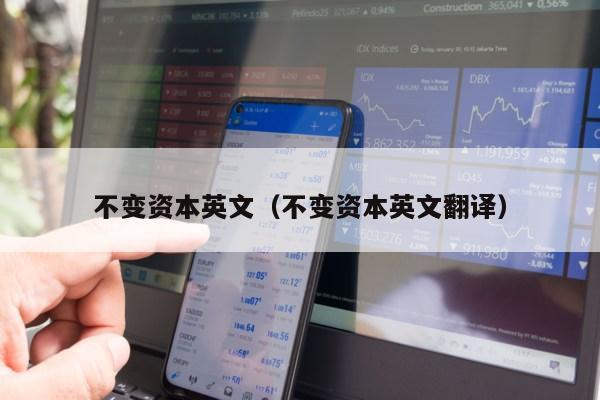不变资本英文(不变资本英文翻译)
- 证券
- 2023-05-14
- 138

摘要:As part of Marxist economic theory, constant capital is a key concept in understanding the capitalist mode of production. Constant capital refers to the fixed assets used in the production process, such as machinery and buildings, that do not change their value during production. In this article, we will explore the concept of constant capital in-depth, its importance in capitalist production, its impact on labor and exploitation, and its relationship with other forms of capital.
1. What is Constant Capital?
Constant capital is a Marxian concept referring to the part of capital invested in fixed assets, i.e., goods that do not change their value during production. These fixed assets include machines, equipment, buildings, raw materials, and other inputs that are essential for producing commodities.
In contrast, variable capital refers to the portion of capital that is spent on labor—the wages paid to workers. The value of variable capital changes as it is turned into commodities by labor power.
The distinction between constant and variable capital is crucial in Marxian economics, where profit is understood as the difference between the total value of the output produced and the cost of production, including the wages paid to workers (variable capital) and the value of the fixed assets used (constant capital).
2. The Importance of Constant Capital in Capitalist Production
Constant capital plays a critical role in capitalist production and the accumulation of capital. Capitalists invest in fixed assets to boost productivity and reduce production costs. With more efficient production, they can produce more goods and increase profits.
The importance of constant capital also means that capitalists must continually invest in new technologies and equipment to remain competitive. This imperative drives technological progress, innovation, and modernization across industries.
Another way that constant capital affects capitalist production is through the creation of a reserve army of labor. As machines and other fixed assets are introduced into the production process, fewer workers are needed to produce the same amount of goods. This leads to unemployment, which drives down wages and increases the exploitation of the remaining workers.
3. Constant Capital and Labor Exploitation
The introduction of constant capital in production has significant implications for the working class. Marx argued that capital accumulation through the investment in fixed assets created the conditions for the exploitation of labor.
Since fixed assets do not change their value during production, they do not contribute to the creation of new value. Only labor power can create new value. However, this new value is divided unequally between capital and labor. As the value of constant capital invested increases, the ratio of variable capital to constant capital decreases, leading to a higher rate of exploitation of workers.
In other words, as constant capital becomes more important in production, labor's share of the total value created by the production process decreases, while capitalists' share increases. This dynamic leads to an increasing gap between laborers' wages and the value they produce, leading to increased exploitation and class struggle.
4. Constant Capital and Other Forms of Capital
Constant capital is only one form of capital employed in capitalist production. Another critical form of capital is circulating capital, which refers to the inputs used in production that are not fixed assets and whose value changes during the production process, such as raw materials and intermediate goods.
The relationship between circulating capital and constant capital is complicated and varies across industries and historical periods. In some cases, such as high-tech manufacturing, constant capital may account for a more significant share of the total capital invested, while in others, such as agriculture, circulating capital may be more important. However, the overall trend in capitalist development is towards the increasing importance of constant capital and the domination of fixed assets in the production process.
总结:
In conclusion, the concept of constant capital is an essential part of Marxist economic theory, providing a crucial tool for understanding capitalist production, labor exploitation, and accumulation. By investing in fixed assets, capitalists aim to increase productivity and profits, leading to greater exploitation of labor and the creation of a reserve army of unemployed workers. The relationship between constant capital and other forms of capital is complex, but the trend over time is towards the increasing dominance of fixed assets in the production process.
This dynamic has significant implications for the nature of work, class struggle, and the future of capitalist development, highlighting the critical role of Marxist analysis in understanding contemporary economic, social, and political challenges.























